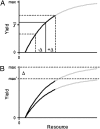Global growth and stability of agricultural yield decrease with pollinator dependence
- PMID: 21422295
- PMCID: PMC3078347
- DOI: 10.1073/pnas.1012431108
Global growth and stability of agricultural yield decrease with pollinator dependence
Abstract
Human welfare depends on the amount and stability of agricultural production, as determined by crop yield and cultivated area. Yield increases asymptotically with the resources provided by farmers' inputs and environmentally sensitive ecosystem services. Declining yield growth with increased inputs prompts conversion of more land to cultivation, but at the risk of eroding ecosystem services. To explore the interdependence of agricultural production and its stability on ecosystem services, we present and test a general graphical model, based on Jensen's inequality, of yield-resource relations and consider implications for land conversion. For the case of animal pollination as a resource influencing crop yield, this model predicts that incomplete and variable pollen delivery reduces yield mean and stability (inverse of variability) more for crops with greater dependence on pollinators. Data collected by the Food and Agriculture Organization of the United Nations during 1961-2008 support these predictions. Specifically, crops with greater pollinator dependence had lower mean and stability in relative yield and yield growth, despite global yield increases for most crops. Lower yield growth was compensated by increased land cultivation to enhance production of pollinator-dependent crops. Area stability also decreased with pollinator dependence, as it correlated positively with yield stability among crops. These results reveal that pollen limitation hinders yield growth of pollinator-dependent crops, decreasing temporal stability of global agricultural production, while promoting compensatory land conversion to agriculture. Although we examined crop pollination, our model applies to other ecosystem services for which the benefits to human welfare decelerate as the maximum is approached.
Conflict of interest statement
The authors declare no conflict of interest.
Figures






References
-
- United Nations 2009. World population prospects: The 2008 revision population database. Available at: http://esa.un.org/unpp/. Accessed July 8, 2010.
-
- Food and Agriculture Organization of the United Nations ProdStat and PriceStat databases. 2010. Available at: http://faostat.fao.org/site/526/default.aspx. Accessed January 2, 2010.
-
- Foley JA, et al. Global consequences of land use. Science. 2005;309:570–574. - PubMed
Publication types
MeSH terms
LinkOut - more resources
Full Text Sources

